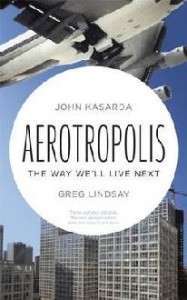Aerotropolis: The Way We’ll Live Next is a new book that makes the case that successful cities in the future will be airport-centric. One of the authors is John Kasarda, the godfather of the aerotropolis and a consultant to Memphis. As a result, Memphis is mentioned in the book and in reviews. Because aerotropolis is a concept heavily touted by the Memphis International Airport to the point of branding itself as “America’s Aerotropolis,” the reviews of the book have special interest for us.
Here’s a review from London’s Guardian:
Aerotropolis: The Way We’ll Live Next by Greg Lindsay and John Kasarda – review
Will the urban centres of tomorrow be built around large, busy airports? Rowan Moore does not think so
From The old city is no more. The future belongs to places such as New Songdo in South Korea, a wholly new city being built on an artificial island and linked by road bridge to Incheon international airport. And to 500 cities of the same size, as yet unborn, that China needs. And to Memphis, Tennessee, home of Fedex, and the UPS city of Louisville, Kentucky.
These, says Greg Lindsay, showing a suitably 21st-century indifference to the ancient Greek plural of “polis”, are “aerotropoli”. An aerotropolis is a city with an airport at its centre, rather than its periphery, “a new kind of city, one native to our era of instant gratification – call it the instant age”. It is “a new phenomenon… reshaping the way we live and transforming the way we do business”. Cities such as London, forever dithering over a third runway at Heathrow, and Los Angeles, where nimbies keep blocking the expansion of LAX, and New York, with sclerotic links from the city to its airports, are in trouble.
Lindsay is a journalist fascinated by air travel. His co-author is John Kasarda, a business school professor with presumably lucrative consultancies telling countries, cities and businesses how to prepare for this new age. Lindsay wrote and did much of the exploration for Aerotropolis; Kasarda supplied much of the wisdom.
The book tells how the world is rearranged by the logic of time, distance and cost. In 1974, for example, the Japanese Airlines executive Akira Okazaki used the spare capacity on cargo flights to fly whole chilled tuna around, leading to the world-wide consumption of sushi, with the result that bluefin tuna is now endangered in the Gulf of Mexico and the Mediterranean. When political protests closed Bangkok’s Suvarnabhumi airport, hotels ran out of imported milk and fish, but filled with orchids that could no longer be flown out.
The authors address obvious counter-arguments. They do not accept that electronic communication will reduce demand for flying, instead pointing out that increased communication and increased travel have always gone together. If people make friends through Facebook, they may want to fly to meet up. Amazon stirs up a whirl of airborne goods, and business deals arranged by email need eye-contact and handshakes to be consummated. As for ecological objections, they argue that air transport causes a relatively small proportion of emissions. Roses imported to Britain from Holland, for example, are far more carbon-hungry than those from Kenya, because the hothouses and fertiliser needed to grow them outweigh the savings on fuel costs.
Aerotropolis also describes the kinds of space formed by flight, the concourses and hubs that Douglas Coupland called “an in-between place, a ‘nowhere’, a technicality… an anti-experience… like what happens to you just after you die and before you get shipped off to wherever you’re going… pure neutrality made concrete”. The patron saint of such places is George Clooney, as the flying, heartless, corporate assassin in Up in the Air. Walter Kim, author of the book on which the film was based, has contributed a plug for the front cover of Aerotropolis. “Throw out your old atlas,” it says. “The new one is here.”
I have to say, I have heard much of this before: in Martin Pawley’s Terminal Architecture of 1998, in Rem Koolhaas’s S,M,L,XL(1995), in Deyan Sudjic’s The 100 Mile City (1993), in Marc Augé’s Non-Places (1992), in the writings of JG Ballard, even in Alexander Korda’s 1936 film of HG Wells’s Things to Come. Despite all this historic futurology, there seem to be quite a lot of boring old cities around still doing reasonably well. The really interesting question is why the true aerotropolis, despite compelling reasons for its existence, is taking so long to get off the ground.
The examples cited in the book are not completely convincing, and form an unintentional anti-prospectus for Kasarda’s consultancy business. There is the city that was to be built next to Bangkok’s airport, with advice from Kasarda, but didn’t happen. Reunion, a development close to Denver international airport, “a community specifically created for the pursuit of happiness”, ended up with one of the highest foreclosure rates in the region. Wilmington, Ohio, lavishly wooed DHL with public money, only to be dumped when the company’s profits went the wrong way. Memphis, despite the blessing of Fedex, “still has a long way to go”. There is the growth around Washington’s Dulles airport, which owes as much to vast contracts from the Pentagon as to the airport. There is Dubai.
It is hard, yet, to find a true aerotropolis, a thriving, rich city formed around an airport, outside the promotional spiels that promise New Songdo will be “A cool city! A smart city!”. Human factors, such as the fear of planes falling on your head, or attachment to a place, or political manoeuvring, or the persistence of non-aeronautic networks, counteract that other human factor, the desire for eye-contact, which seems to drive the immense machinery of air travel.
The less spectacular truth is that cities have always relied on transport, but not on transport alone. Airports are a powerful force among others, and it is the interaction of these forces that makes cities interesting. Aerotropolis is straining too hard to be a smartypants bestseller of the the type produced by Malcolm Gladwell to explore this complexity. It is hectoring, breathless, over-persuading, a boring book with an interesting one struggling to get out. And it undermines itself in the authors’ biographical note: Lindsay lives not in Memphis or any other aerotropolis, but in Brooklyn, in the dinosaur city of New York – not, presumably, because of its airports.
From New York Times:
City of the Future: An Airport?
By MICHAEL POWELL
To find yourself at La Guardia Airport, that repository of bad food, dim lighting, unsettlingly indistinct odors and too-short runways, is to be inclined toward embracing John D. Kasarda and Greg Lindsay and all they have to say about the future of travel and modern life.
Kasarda, a professor in the business school at the University of North Carolina who has consulted with four White House administrations and numerous cities and governments, believes that something very different from La Guardia is transforming our world: the gleaming “aerotropolis,” with a state-of-the-art airport at its center, surrounded by customized transportation links, fine restaurants, designer shopping and nearby corporate suburbs connecting workers umbilically to the global marketplace. The aerotropolis, he says, represents not just a redesign of travel but a vital new economic paradigm. From the United States to Holland to Dubai, no nation in this “frictionless” age of fast-paced and highly competitive trade can long survive without airport hub cities built to spec.
Kasarda’s theories are presented in the ambitious “Aerotropolis: The Way We’ll Live Next,” which is written by Lindsay, who as the journalist onboard fulfills the role of eager messenger. Kasarda is less co-author than inspirational Yoda, supplying the vision and the immutable “laws” of development for 21st-century life — emphasis on location, accessibility and speed. Lindsay, meanwhile, flies around the world, conducting interviews, seeking evidence, translating Kasarda’s technical jargon into a lively if sometimes flawed work of pop behavioral economics.
Lindsay explains that in Kasarda’s view, the aerotropolis is to the 21st century what the port was to the 16th, 17th and 18th: an indispensable building block upon which nations, economies and cultures will rise or fall. The “biggest build-out” of cities “in human history will reset the global pecking order,” Lindsay writes, adding that to Kasarda, the aerotropolis offers an “antidote” to overcrowded megalopolises while “imposing a hierarchy of needs on cities so that they openly and honestly express their true purpose: creating work for their inhabitants and competitiveness for their nations.”
O.K., you may be tempted to say. Anything to escape La Guardia. But read on, and it’s difficult to resist tossing out exceptions to Kasarda’s assertions. London, Paris, Rome and, yes, New York are on any short list of great cities that have so far survived without being proper aerotropolises. And there are more than a few aerotropolises — Louisville, Memphis and Hyderabad, India, not to mention Dallas-Fort Worth — whose airports have beautiful runways and spectacular warehouses, whose suburbs are elegantly appointed and whose corporate parks send glass structures rising toward the sky, but which nonetheless fall a few watts short of electrifying “global cities.”
“Aerotropolis” offers intriguing arguments and hypotheticals, but it too often feels overwrought and overstuffed. Kasarda insists on the inevitability of his vision, and while Lindsay acknowledges a shadow or two of doubt, he most often concludes that we have but one choice: to jump aboard Kasarda’s plane.
Which is not to say that the authors fail as provocateurs. Lindsay explains well, for instance, why Los Angeles has put itself at a competitive disadvantage by failing to build a world-class airport. He quotes the operations manager at Los Angeles International, who says that “80 percent of all iPods sold at Christmas last year” went through LAX, most of them delivered from Hong Kong by Cathay Pacific 747s. But those same planes are as likely to cruise over Los Angeles, with “its tangle of runways and freeways,” to a proper aerotropolis, like Dallas-Fort Worth. Los Angeles “has begun a slow descent into flyover country as far as cargo is concerned,” Lindsay writes. “It’s Yogi Berra logic: nobody lands there anymore; it’s too crowded.”
Nor does Lindsay shy from pointing out the underside of the aerotropolis. He describes the proliferation of “relovilles,” suburbs populated by “relos,” the corporate-ladder-climbing men and women regularly uprooted by their employers. In relovilles, “homes, subdivisions, office parks and even cities become disposable,” Lindsay writes. “Life . . . has about as much permanence as a plane ticket. In the aerotropolis, that’s not weird, it’s normal.”
He also draws an effective portrait of the alienated life of the airport-hopping corporate manager. Although you might think, “I’ve seen this George Clooney movie before,” Lindsay explores the ramifications of the itinerant lifestyle sensitively, suggesting that our “freedom” to live anywhere with wireless Internet service and a great hub is a bittersweet gift.
“Aerotropolis” is bracing in its dissection of the conceit of locavorism, the insistence that locally produced and consumed food is suffused with moral virtue. So restaurants in Burlington, Vt., love to use only the best organic tomatoes from the Mad River Valley; the better bistros in Sausalito, Calif., reserve a place for the finest Sacramento radishes. As Lindsay explains, this cannot possibly be the end of it, in terms of economics or morality. To forgo coffee from Ethiopia or roses from Kenya because a jet burns fuel delivering those products is to condemn millions of African farmers to a short and brutish life. African roses, “planted in the earth and left to bloom under the equatorial sun,” use far less energy than northern roses raised in greenhouses with fertilizer drips. The virtuous shopper risks beggaring the poorest of the world’s citizens.
Lindsay is less persuasive when discussing air travel’s effects on global warming. Taking on theories about peak oil, scarcity, carbon emissions — anything that might argue against flight — he concludes, “Aviation’s contributions to our well-being are larger and growing more rapidly than its carbon emissions.” But this is too breathless. He omits research suggesting that jet contrails’ impact on climate change, particularly in certain regions, is likely to grow as air traffic increases. It would have been enough for him to note, as he does in a section called “The Doomslayers,” that James Hansen, the NASA climate scientist, has said that coal-burning plants and buildings are vastly more damaging than airplanes, and that grounding planes as a solution to climate change would be terrifically disruptive.
More problematic is Kasarda and Lindsay’s tendency to stand causality on its head. They offer a string of factoids to establish the predestined centrality of the aerotropolis: one in six Americans lives within a short driving distance of the 25 busiest hubs; businessmen fly because they trust best those whom they can see. But couldn’t it be true that airport hubs tend to grow up around busy cities? That meeting face to face isn’t always best for business? (A lot of people peered into Bernie Madoff’s eyes and still handed over their money.)
Kasarda’s impatience with human agency is no less troubling. Nations, he says, can ignore his counsel, but a penalty attends. Nimbys in Britain fighting the expansion of runways are shoving their way into history’s dustbin, he argues, soon to be surpassed by avid aerotropolis adopters in Amsterdam or Dubai. “High-functioning autocracies such as Dubai’s don’t faze him,” Lindsay writes. “If anything, they’re the only ones who move fast enough.” It took as long for the English to air their grievances over Heathrow’s Terminal 5 as it did for Beijing to wrest an aerotropolis from raw earth, Lindsay notes. To create its city, the Chinese government also flattened 15 villages, forcing 10,000 people to resettle. The Chinese ministry in charge of the project noted that “democracy sacrifices efficiency.” Kasarda, we are told, was “awed” by this rationale.
The authors of “Aerotropolis” are perhaps to be congratulated for their bluntness and their provocations. But I could not shake the sense that something had gone missing from their vision of our future — something like a soul.
Michael Powell writes on national economics and politics for The Times.




